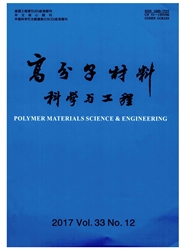

 中文摘要:
中文摘要:
对超临界CO2环境中聚丙烯固相接枝甲基丙烯酸缩水甘油酯反应过程进行了研究。考察了反应时间、CO2的压力、单体用量、引发剂用量以及反应温度对接枝产物接枝率和凝胶率的影响,获得了较优的接枝反应条件。结果表明,与熔融接枝和传统固相接枝过程相比,采用超临界固相接枝过程制得的接枝物具有接枝率高、凝胶率低且降解程度低等优点。同时接枝产物的接枝率和凝胶率除了可通过改变单体用量和引发剂用量进行调节外,还可通过改变CO2的压力进行调节。
 英文摘要:
英文摘要:
The work reported in this paper was aimed at exploring the advantages of using supercritical carbon dioxide (scCO2) as an environmentally benign solvent and swelling agent for carrying out the free radical grafting process of glycidyl methacrylate (GMA) onto isotactic polypropylene (PP) in the solid state. The effects of various factors on the grafted content and gel content were investigated. Those factors include reaction time, CO2 pressure, monomer and initiator concentrations. Results show the scCO2-assisted solid-state process produces much higher grafted content, and less degradation of iPP than the classical solid-state or melt processes does. The gel content of PP-g-GMA obtained by scCO2-assisted solid-state process is less than those obtained by the classical solid-state process. Under scCO2, the monomer and initiator concentrations can regulate the grafted content and gel content with ease and also the CO2 pressure.
 同期刊论文项目
同期刊论文项目
 同项目期刊论文
同项目期刊论文
 Interlocking layer structures formed in spin-cast polymer blend film by surface segregation and self
Interlocking layer structures formed in spin-cast polymer blend film by surface segregation and self Foaming of Poly(lactic acid) Based on Its Nonisothermal Crystallization Behavior under Compressed Ca
Foaming of Poly(lactic acid) Based on Its Nonisothermal Crystallization Behavior under Compressed Ca Effects of Blend Morphology on the Foaming of Polypropylene/Low-density Polyethylene Blends during a
Effects of Blend Morphology on the Foaming of Polypropylene/Low-density Polyethylene Blends during a Manipulation of polymer foam structure based on CO2-induced changes in polymer fundamental propertie
Manipulation of polymer foam structure based on CO2-induced changes in polymer fundamental propertie Solubility and Diffusivity of Carbon Dioxide in Solid-State Isotactic Polypropylene by the Pressure-
Solubility and Diffusivity of Carbon Dioxide in Solid-State Isotactic Polypropylene by the Pressure- 期刊信息
期刊信息
